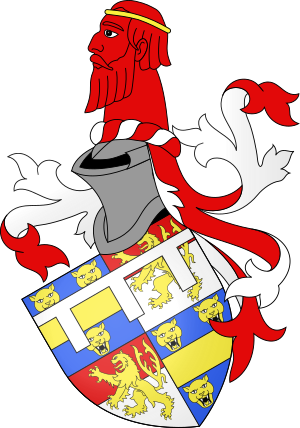John de la Pole, Earl of Lincoln facts for kids
Quick facts for kids John de la Pole |
|
|---|---|
| Earl of Lincoln | |
 |
|
| Born | c. 1460 |
| Died | 16 June 1487 (aged 26–27) East Stoke, Nottinghamshire |
| Spouse | Margaret FitzAlan |
| House | de la Pole |
| Father | John de la Pole, 2nd Duke of Suffolk |
| Mother | Elizabeth of York |
John de la Pole, Earl of Lincoln (born around 1460 – died 16 June 1487) was an important noble during the Wars of the Roses. This was a time when two powerful families, the Yorks and the Lancasters, fought for control of England.
After his uncle, King Richard III, died, John de la Pole made peace with the new king, Henry VII. However, two years later, he led a big rebellion to try and put a different person on the throne. He claimed that a boy named Lambert Simnel was actually his cousin, Edward, Earl of Warwick. Historians believe John de la Pole might have wanted to become king himself if his plan worked. He was defeated and killed in the Battle of Stoke Field in 1487.
Contents
Early Life and Family Connections
John de la Pole was the oldest son of John de la Pole, 2nd Duke of Suffolk. His mother was Elizabeth of York. This made him the nephew of two English kings: Edward IV of England and Richard III of England.
His uncle, King Edward IV, gave him the title of Earl of Lincoln in 1467. This was a very important noble title.
Becoming a Royal Heir
After King Edward IV passed away, John de la Pole strongly supported his uncle, King Richard III. Richard III gave him a lot of money and made him the head of the Council of the North.
When Richard III's own son died, John de la Pole became very important. It seemed like he was chosen to be the next king, even though it was never officially announced. Another person, Edward, Earl of Warwick, had a stronger claim to the throne. But Edward had lost his rights because his father was found guilty of treason.
King Richard III gave John de la Pole important lands and money. He also gave him the income from the Duchy of Cornwall. This was usually given to the person who was next in line to the throne.
Leading a Rebellion
After King Richard III lost the Battle of Bosworth Field in 1485, John de la Pole made peace with the new king, Henry VII. But John soon grew unhappy with Henry's rule.
A priest introduced John to a boy named Lambert Simnel. Simnel looked a lot like Edward, Earl of Warwick, who was actually locked up in the Tower of London by King Henry. John de la Pole decided to use Simnel to pretend he was the "true" heir to the throne. This allowed John to lead the Yorkist supporters himself.
John traveled to Burgundy to ask his aunt, Margaret, Duchess of Burgundy, for money to start a war. Even though he publicly supported Simnel, he likely wanted to become king himself. With an army of paid soldiers, John sailed to Ireland. There, he got help from Gerald FitzGerald, 8th Earl of Kildare. FitzGerald wanted the Yorkists back in power because they had allowed Ireland to govern itself. Simnel was then declared king in Ireland and crowned "Edward VI" in Dublin.
The Battle of Stoke Field
John de la Pole's army grew bigger with Irish soldiers. They landed in Lancashire, England, and marched towards York. York had been a strong supporter of Richard III, but the town refused to let John's army in.
The Yorkists won a small fight at Bramham Moor. John managed to avoid King Henry's main army in the north. This might have been a trick planned by the Yorkists. However, John's army was constantly attacked by Henry's cavalry.
The Yorkists then crossed the River Trent and set up their position on a hill near East Stoke. Soon, the main part of King Henry's army arrived. In the Battle of Stoke Field on 16 June 1487, the Yorkist army was completely defeated. John de la Pole was killed in the battle, along with most of the other Yorkist leaders.
John de la Pole's death did not end his family's claim to the throne. His younger brother, Edmund de la Pole, 3rd Duke of Suffolk, became the main Yorkist claimant. He was later executed by King Henry VIII of England in 1513. Another younger brother, Richard de la Pole, continued the claim until he died in battle in 1525. Their fourth brother, William, was held prisoner in the Tower of London for 37 years.
Family Life
John de la Pole married Margaret FitzAlan, who was the daughter of Thomas FitzAlan, 10th Earl of Arundel. They likely married in the late 1470s. They did not have any children. The date of Margaret's death is not known.

